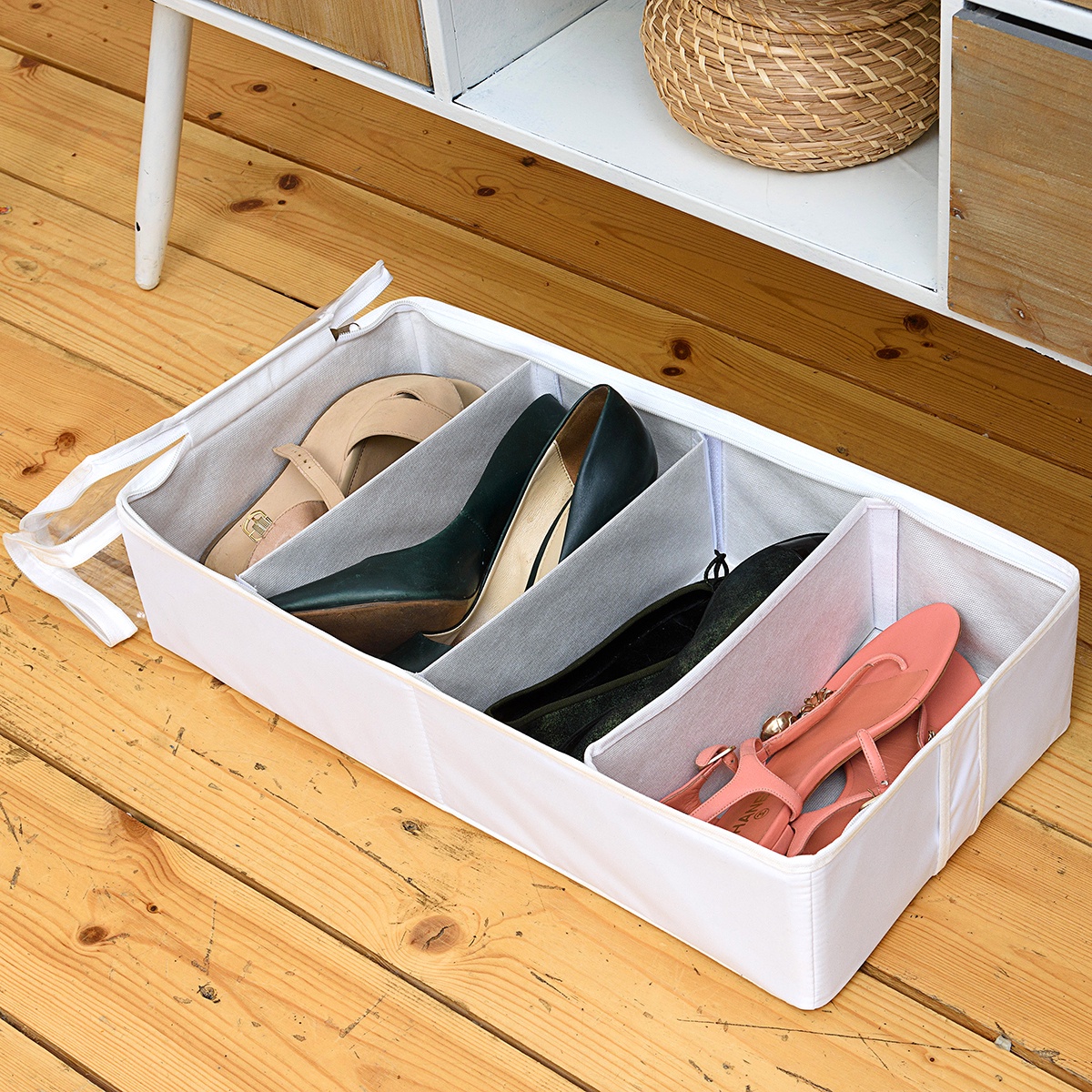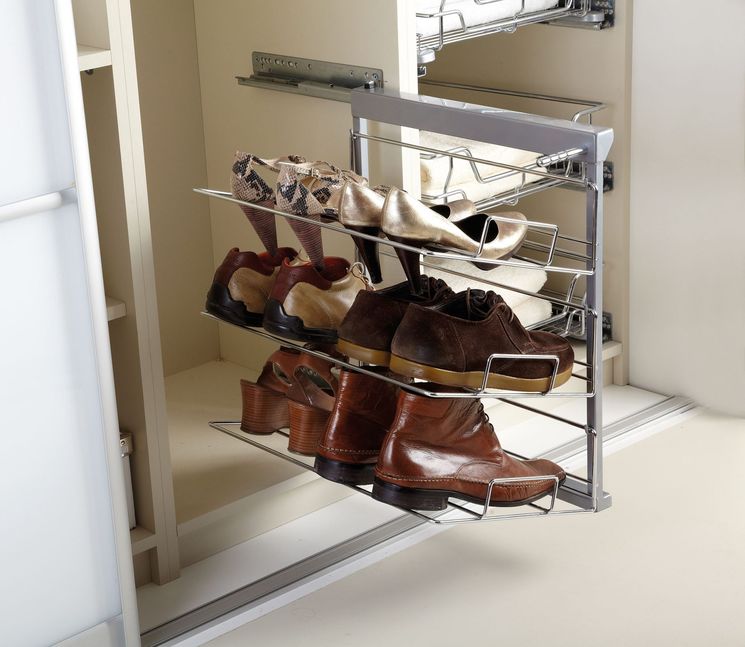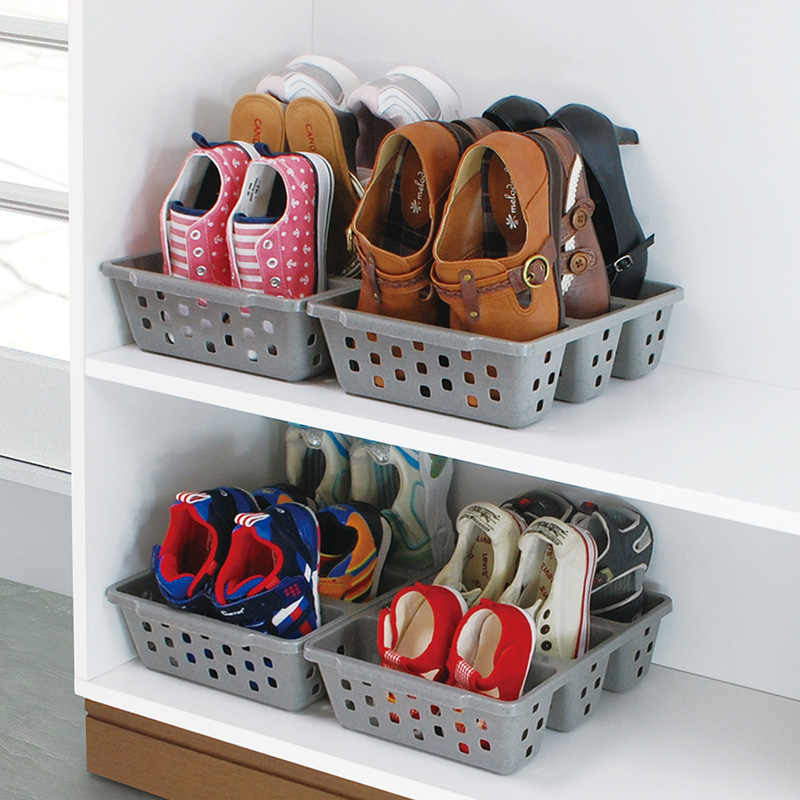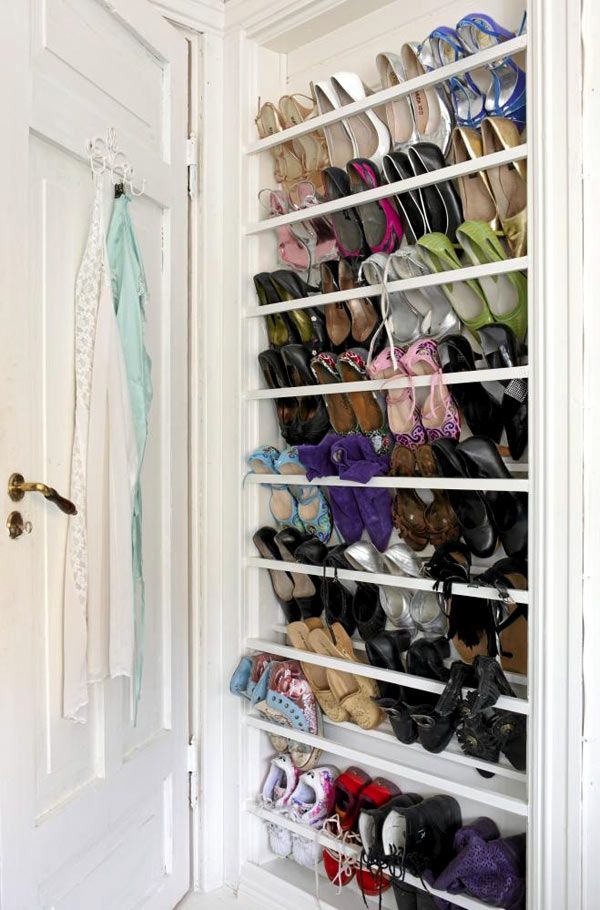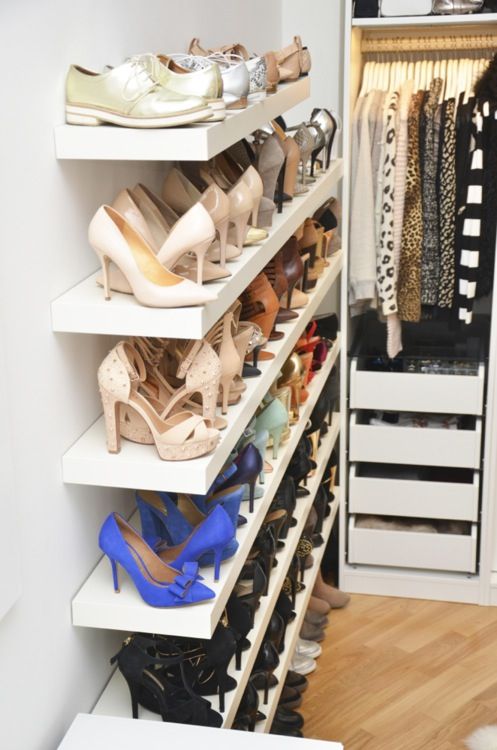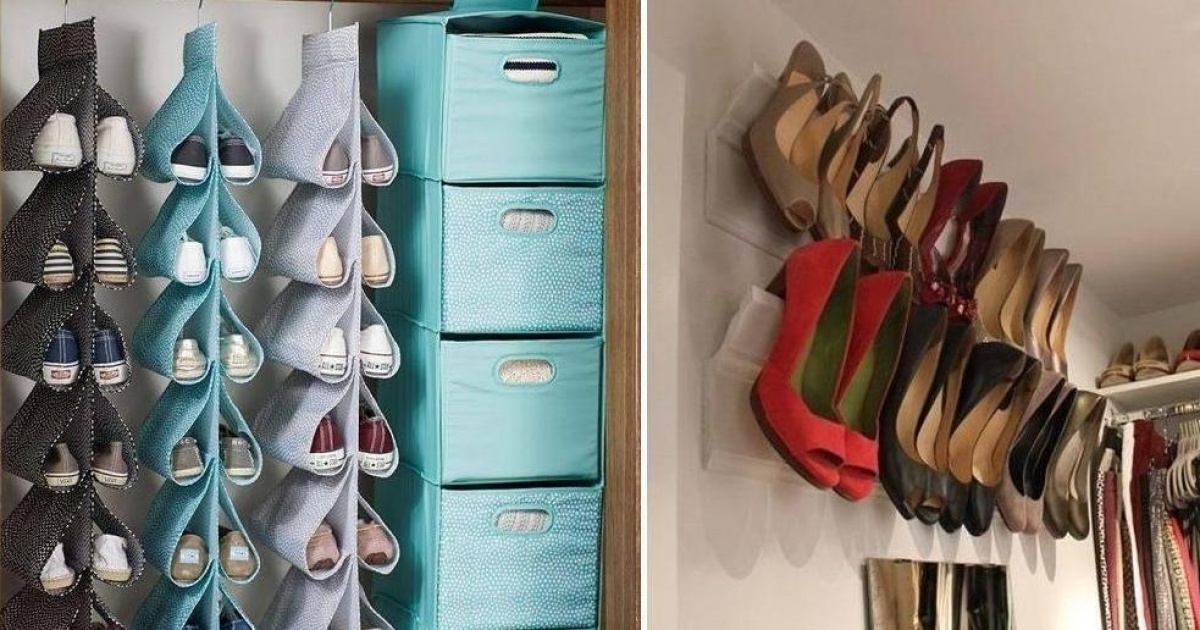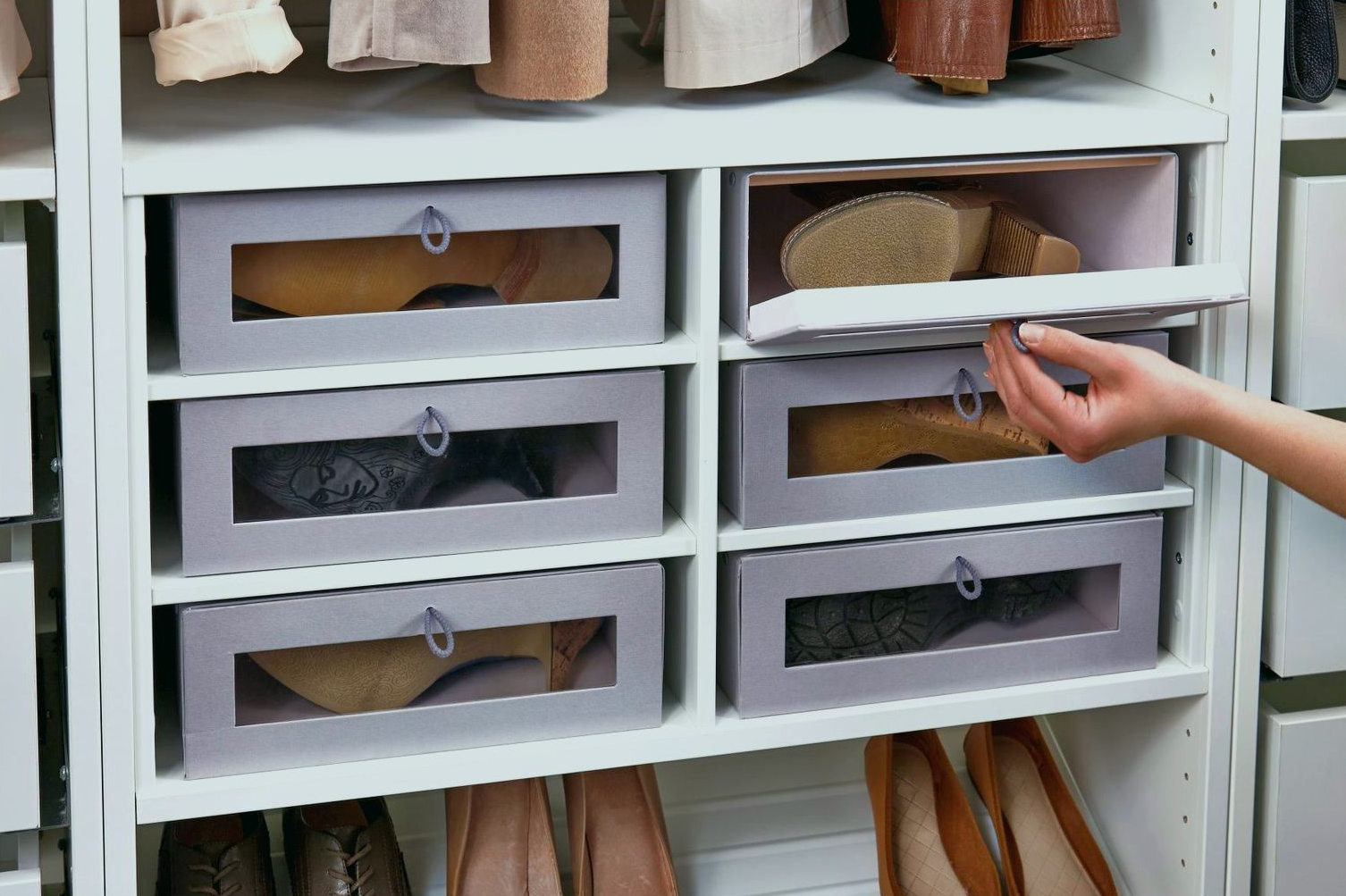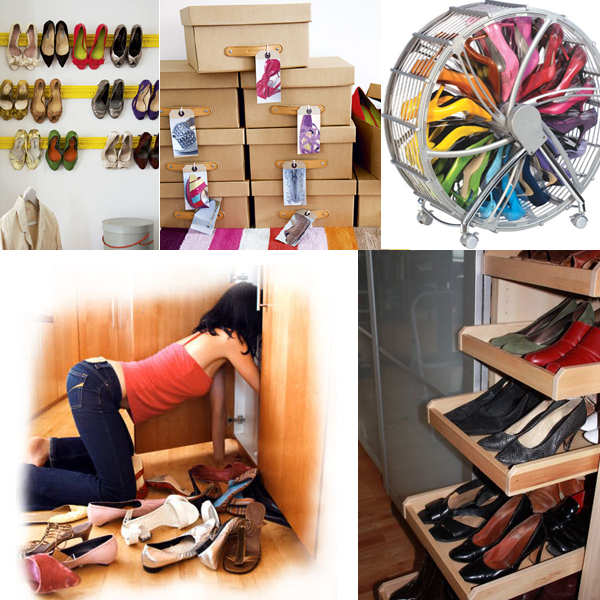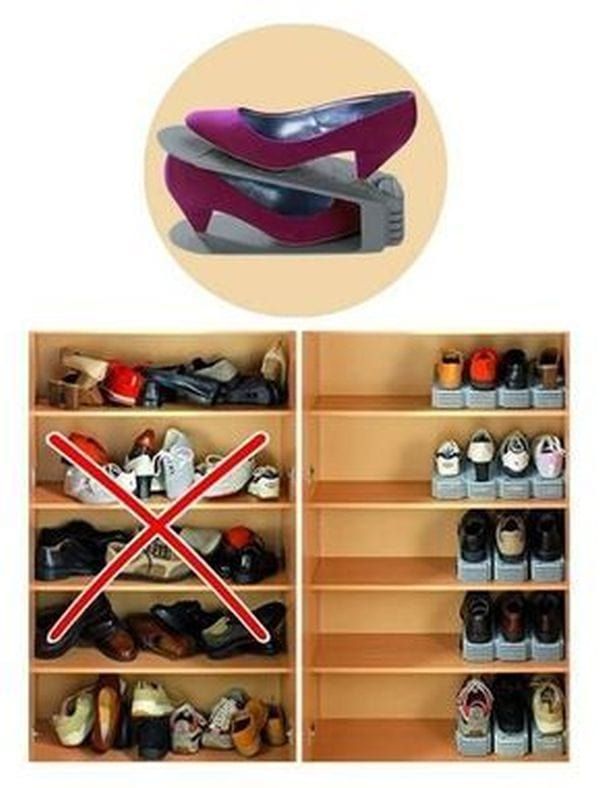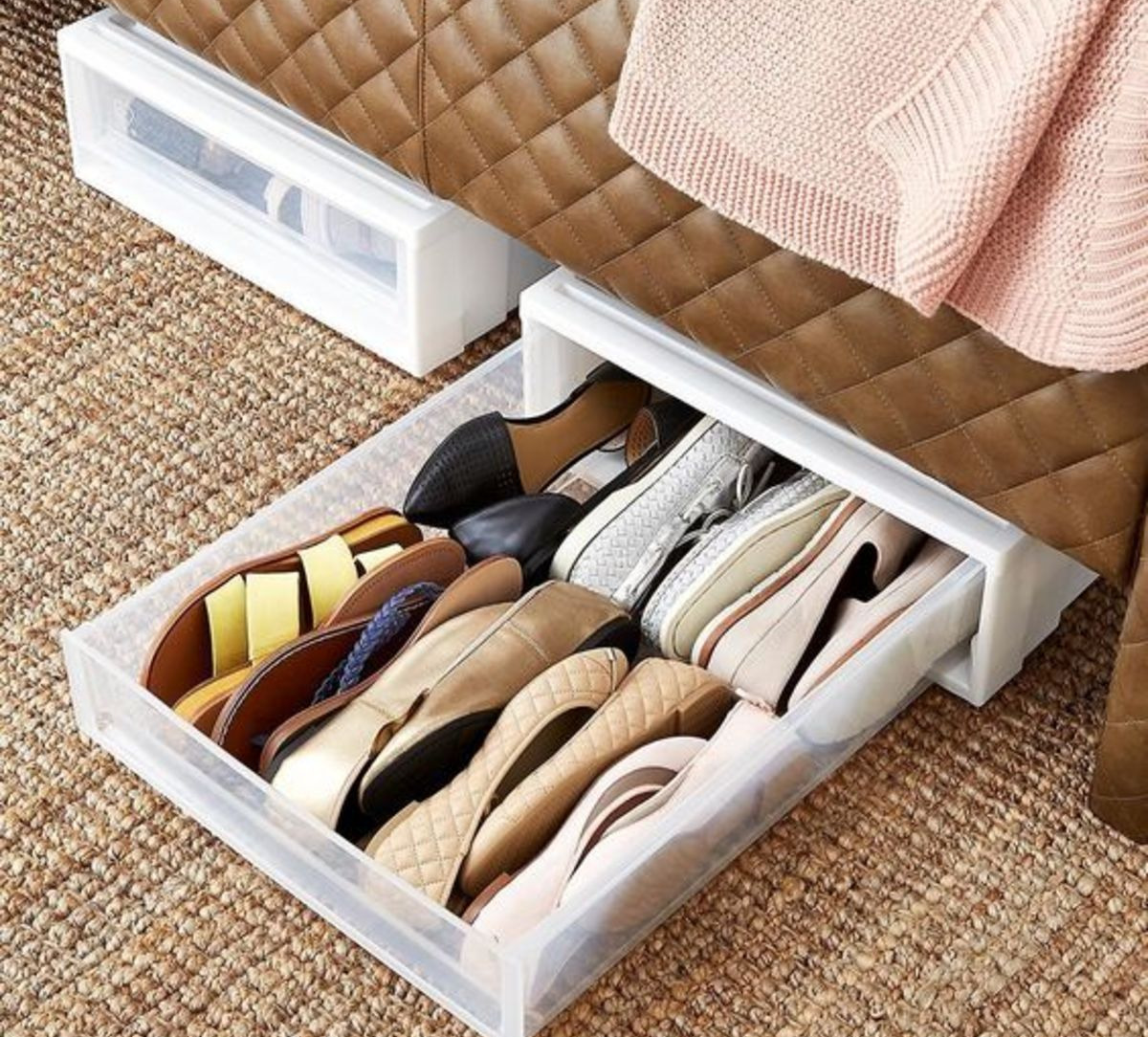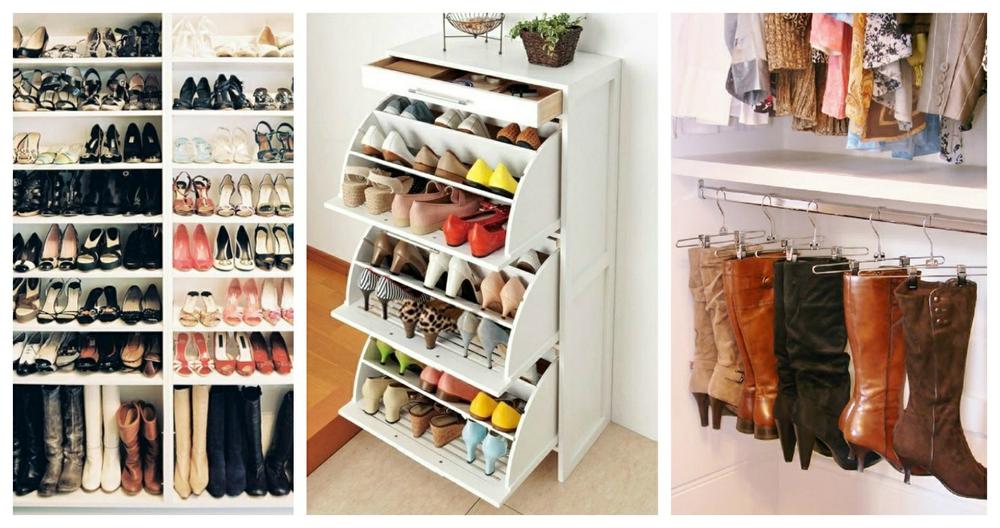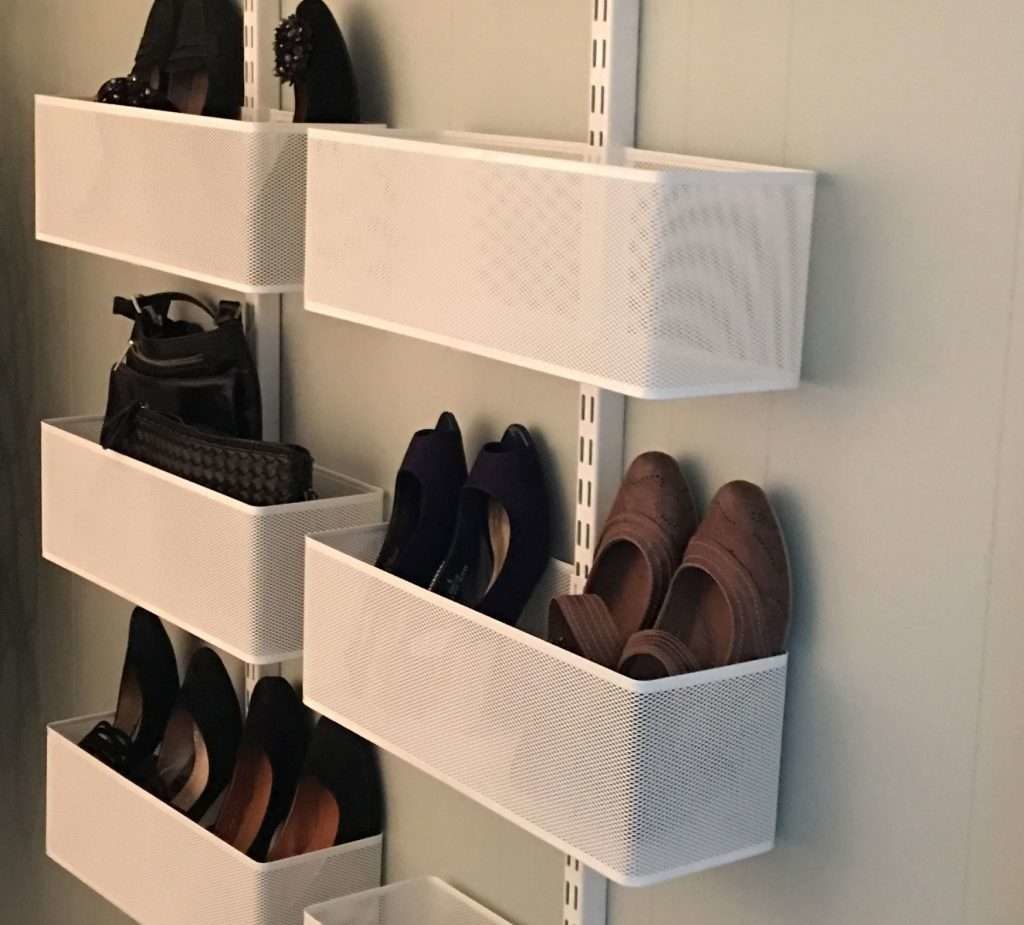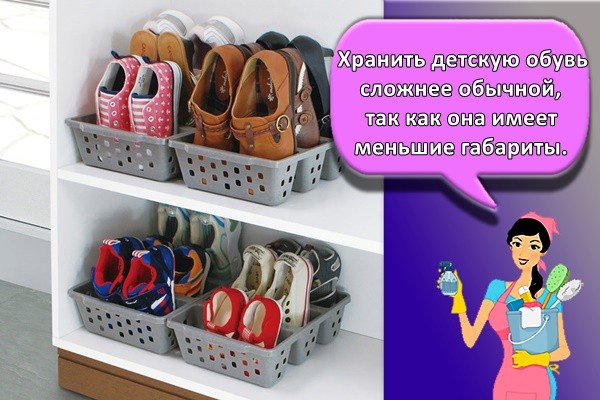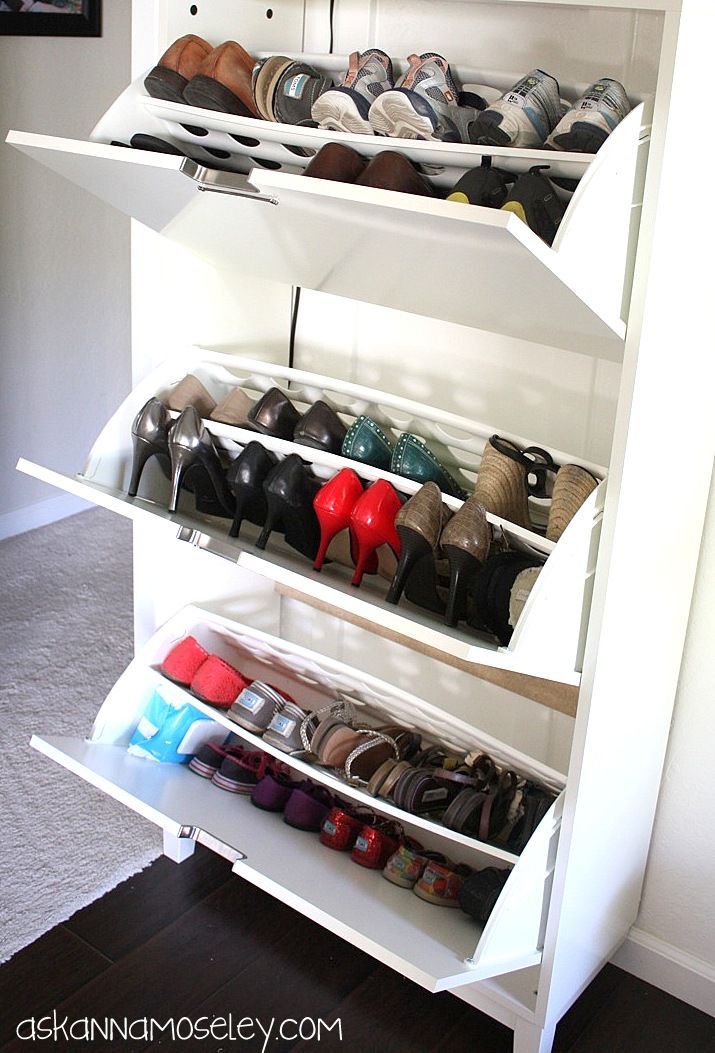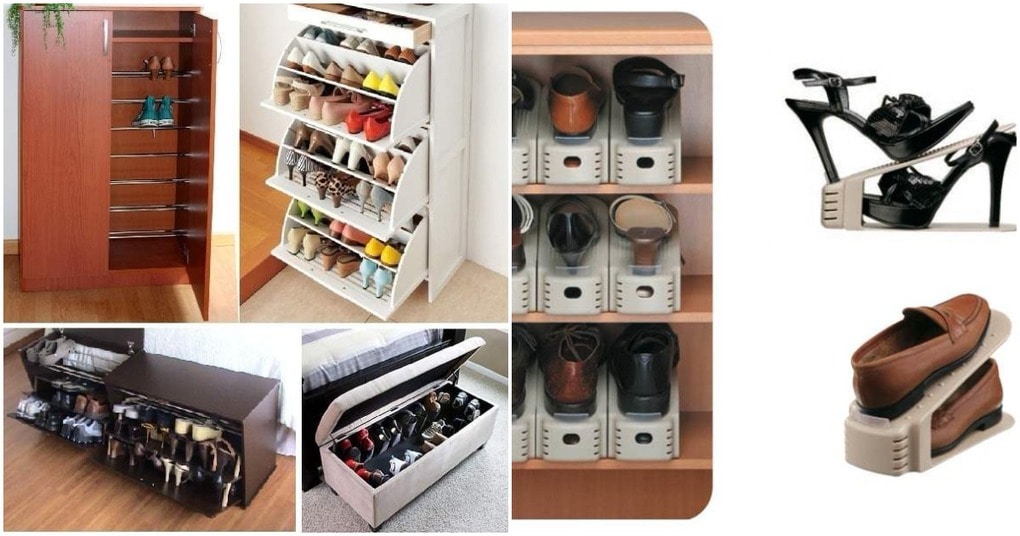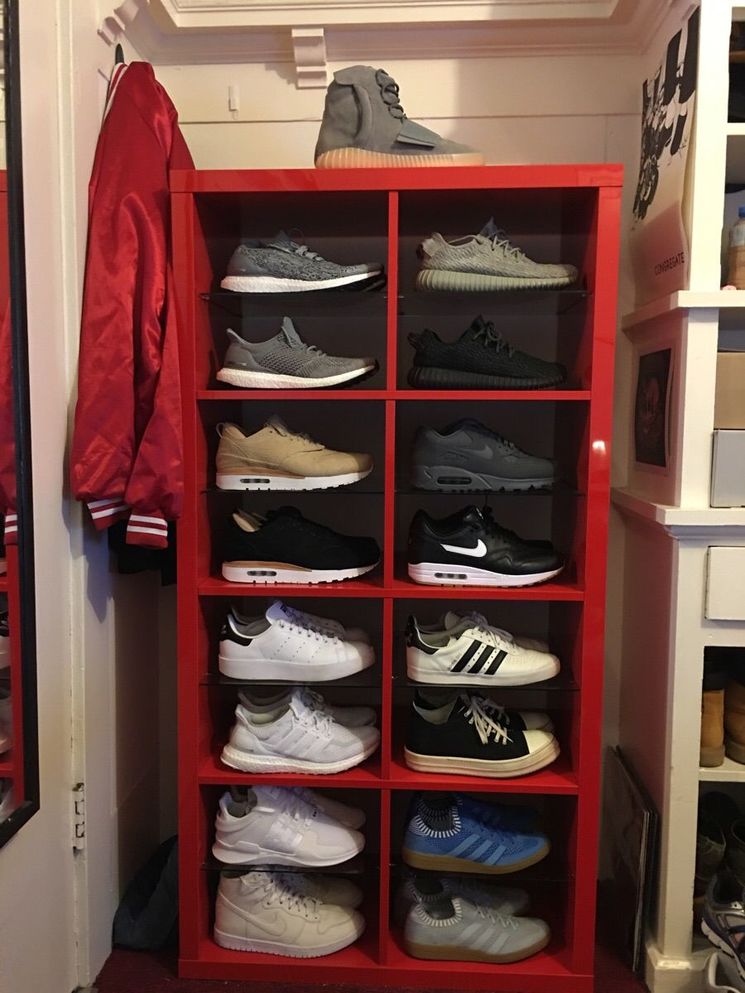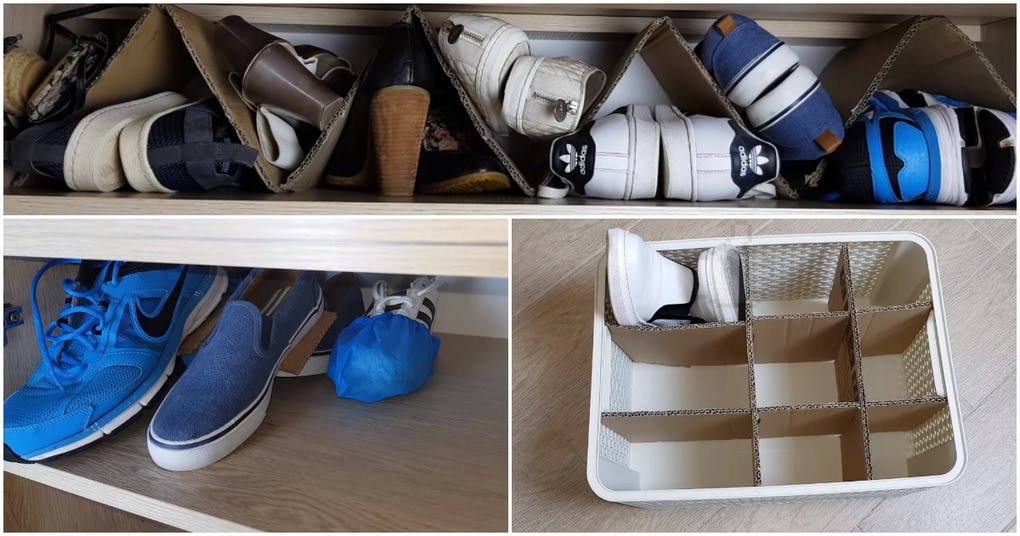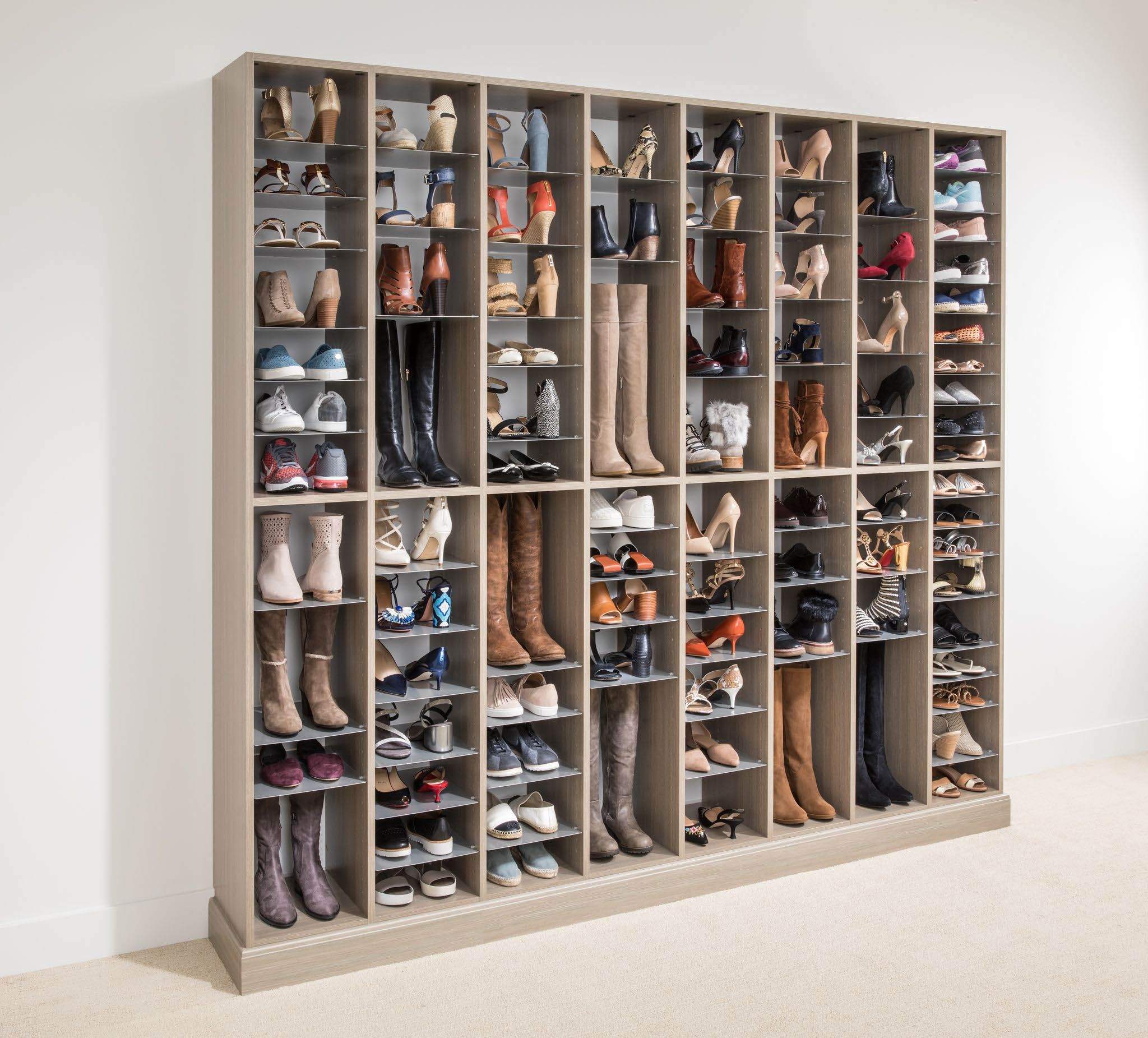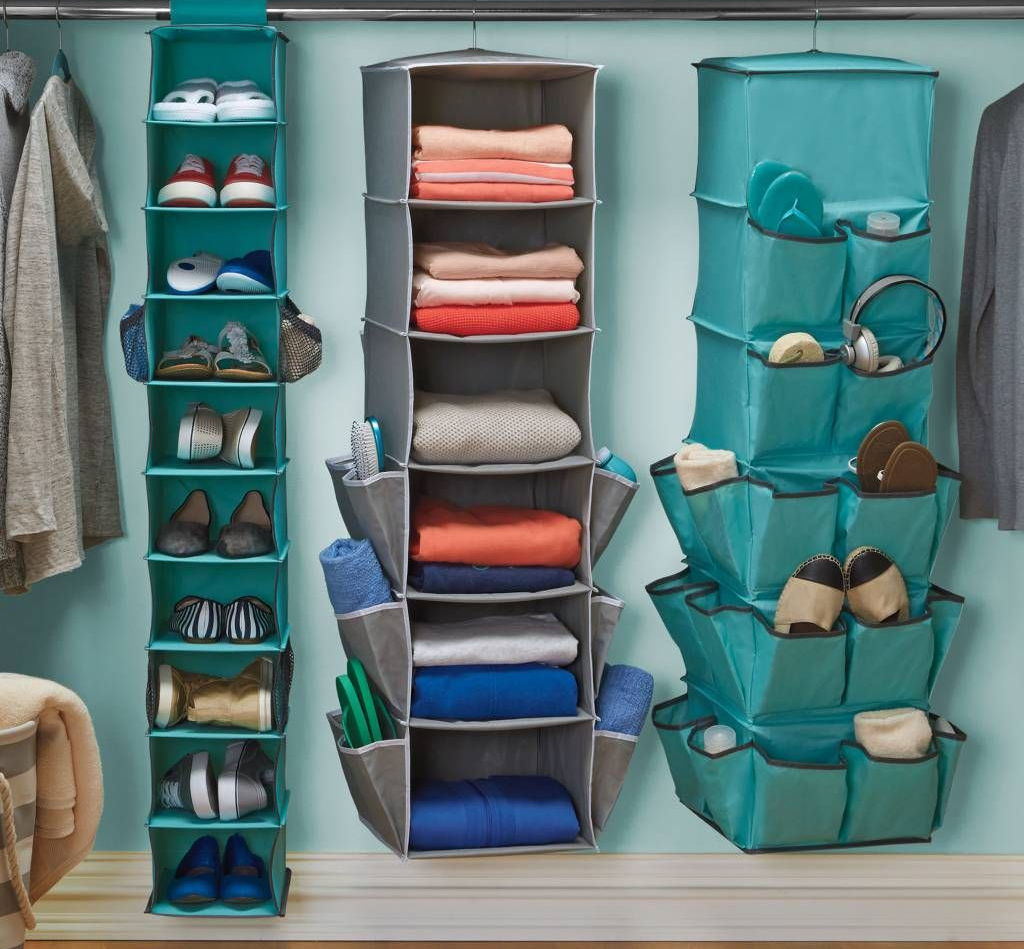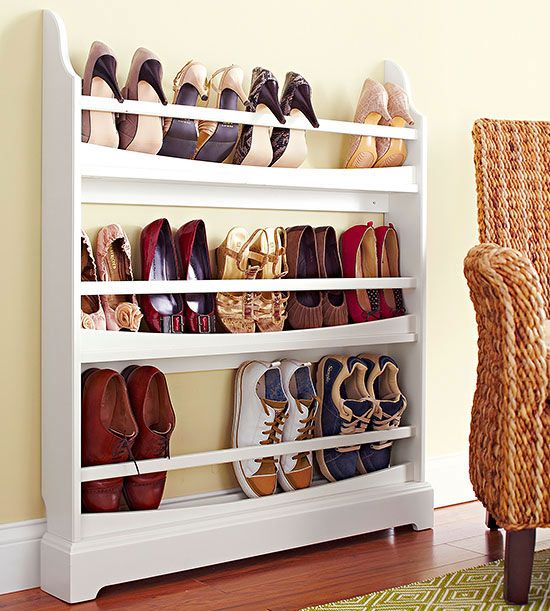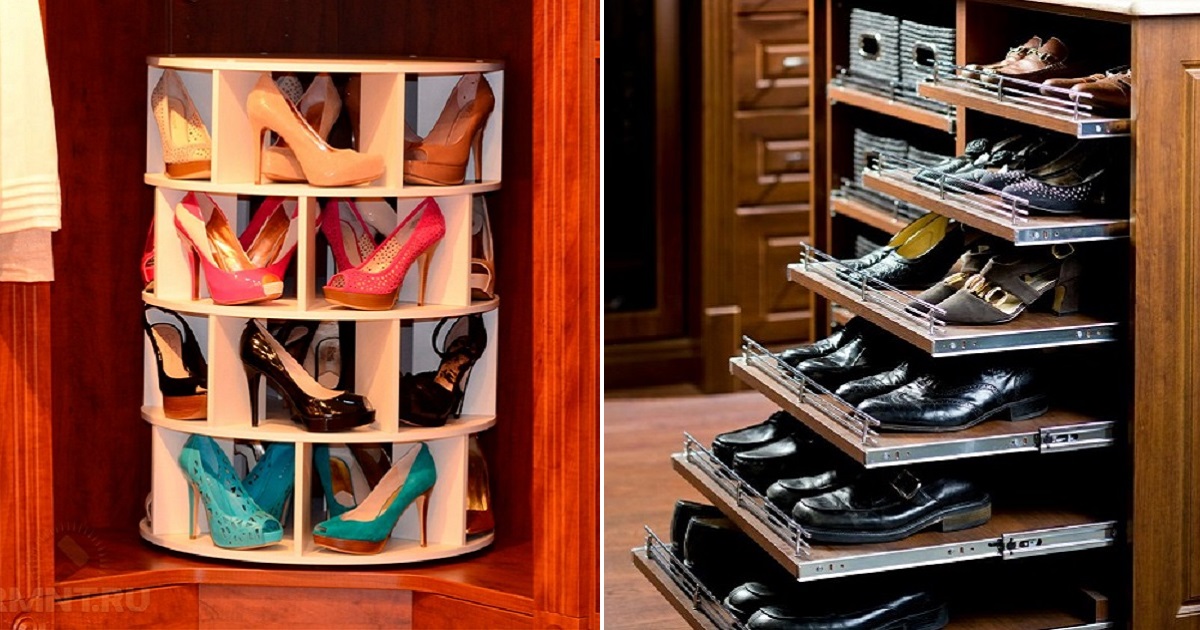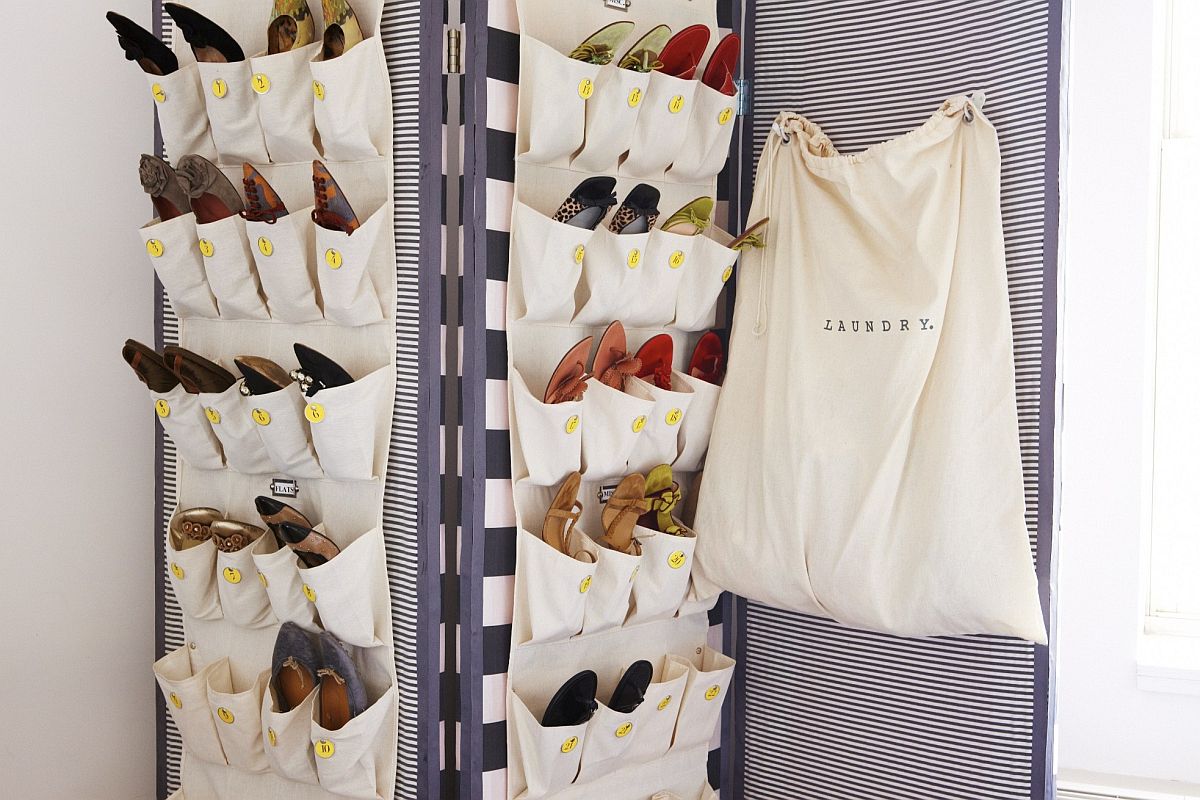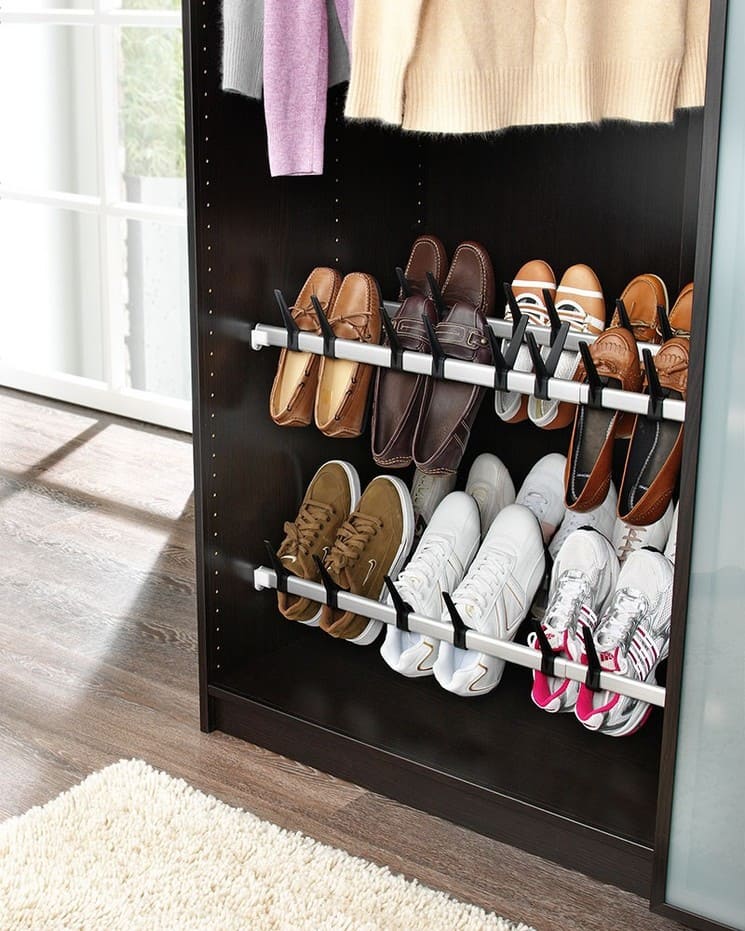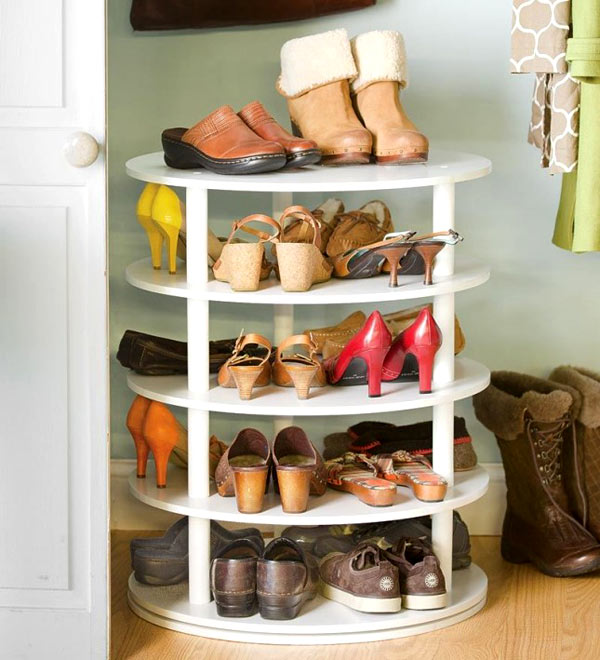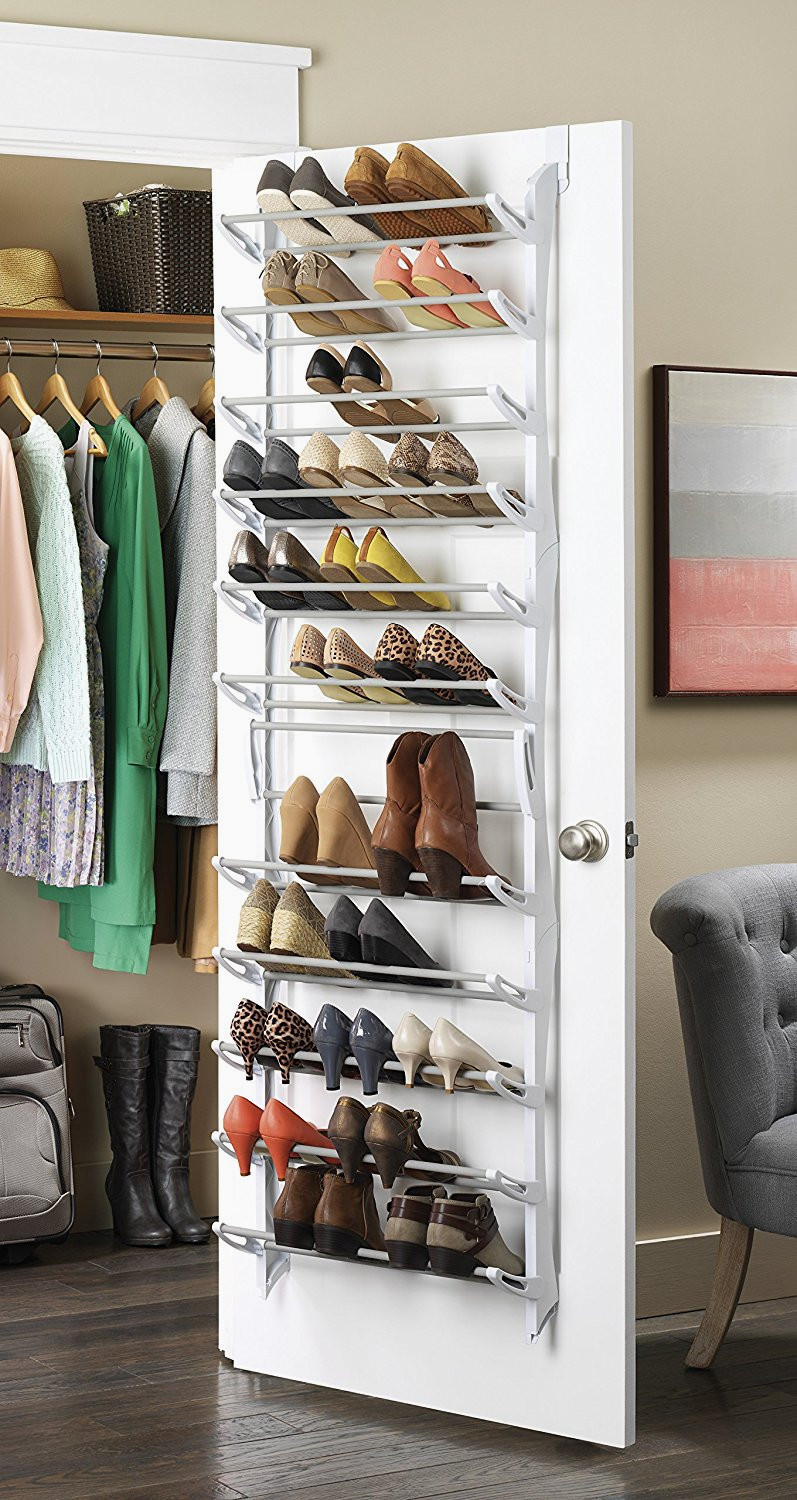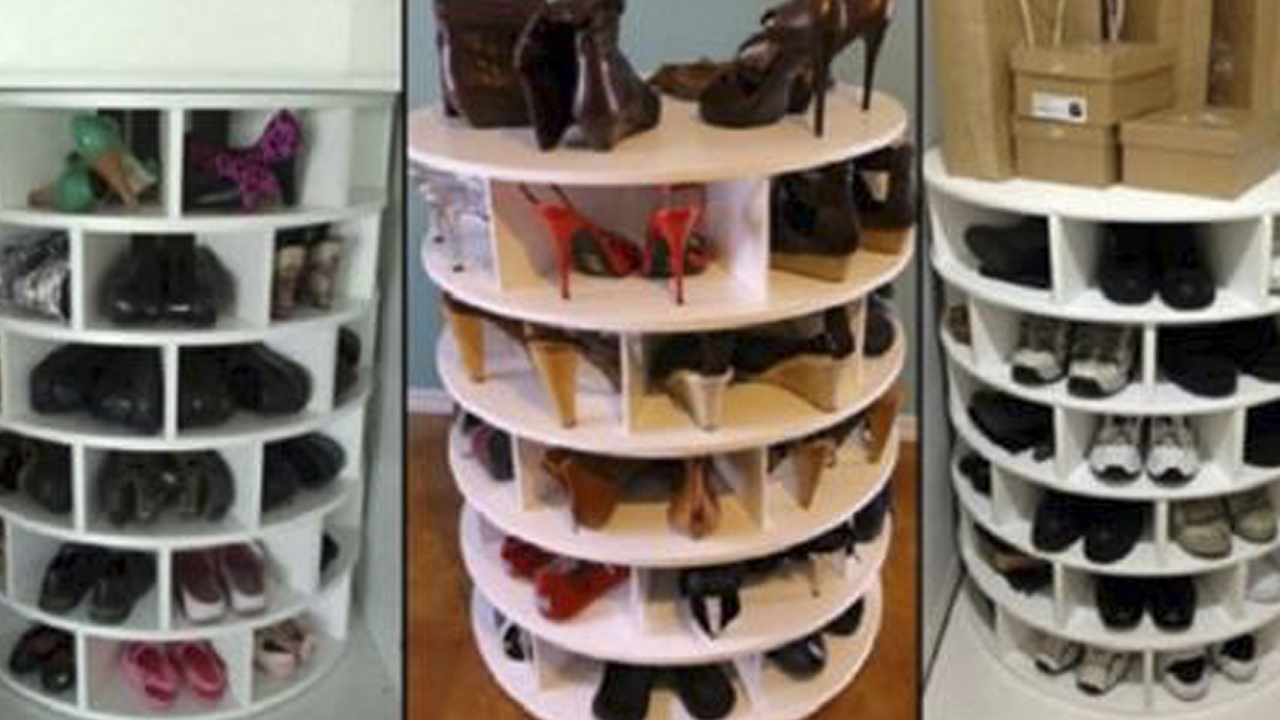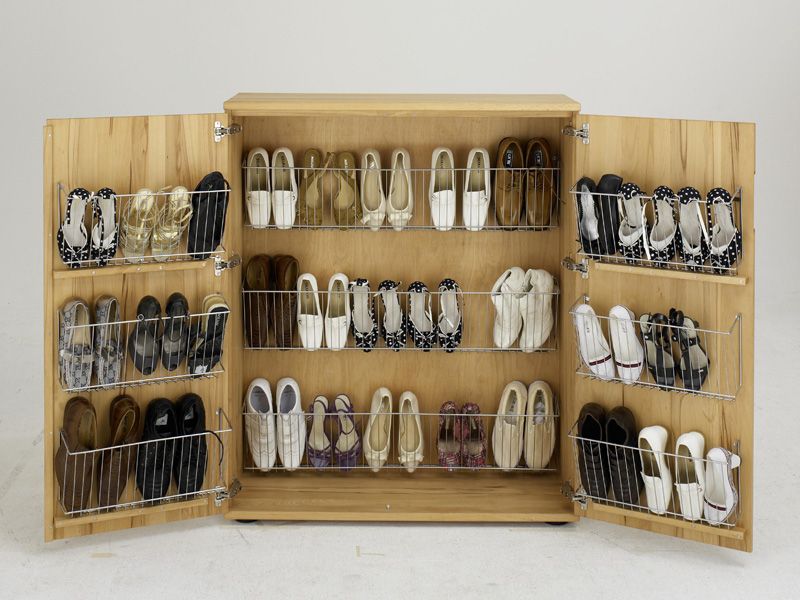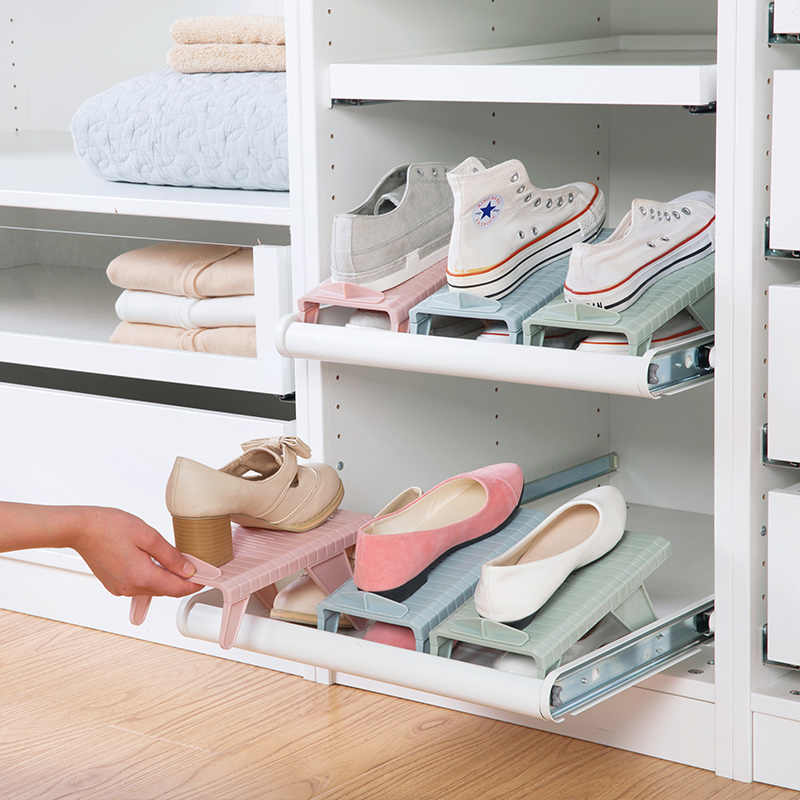Shoe storage racks
The stable frame is equipped with special paddles and tongues for fixing shoes. Summer shoes can be stored on compact spatulas, and boots on high ones. Most of these racks involve vertical placement of shoes, so you should carefully monitor the condition of the shoe soles.
Other models have a lattice surface and outwardly resemble a wide shelf. There are also open and closed racks, which are made in the form of a high and narrow structure from the floor to the ceiling.

The photo shows the interior of the hall with an open-type floor shoe rack.
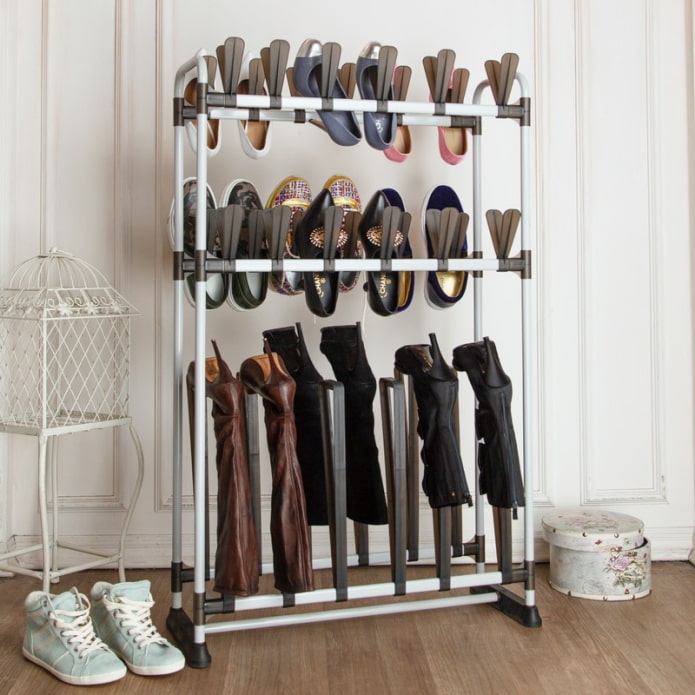

Preparatory stage
Initially, the shoes must be put in order, sorted, and only then decide which storage system will be optimal. It is imperative to conduct an audit and determine the number of pairs. Something may have to be handed over for repair or thrown away.
Wash boots made of natural or artificial leather with warm water. Machine-wash sneakers and fabric shoes. You can use a rubber bristle brush to clean suede garments. Next, you need to dry all the shoes in natural conditions. Treat the outer surface with protective creams, the inner surface with antiseptic agents or special deodorants. For long-term seasonal storage of shoes, it is recommended to use pads or mold holders. This technique will protect shoes and boots from deformation.
It is imperative to disassemble shoes by type, separate men, women and children separately. If each family member has their own closet, then this simplifies the task. Anything that is not needed within 2-5 months should be packed in boxes and placed in the wardrobe. If the shoes will be stored in one place, then when sorting it is necessary to take into account their size, purpose, and the number of pairs.
The place for storing shoes should be dry, well-ventilated, and protected from light. A balcony, loggia, damp pantry or basement must be excluded immediately. All other zones in the apartment can be safely used. For long-term storage, the top shelf of a sliding wardrobe, a shelf in the closet, a mezzanine are suitable. It is more convenient to place the category of shoes for everyday wear in the hallway area. It is advisable to keep the shoes that are put on at the exit in the wardrobe so that they are at hand at the right time.
The type of packaging depends on the number of shoes. If the dressing room is spacious enough, then it is better to choose a separate box for each pair. If you do not have enough space, you should stock up on organizers that can even be placed under the bed.
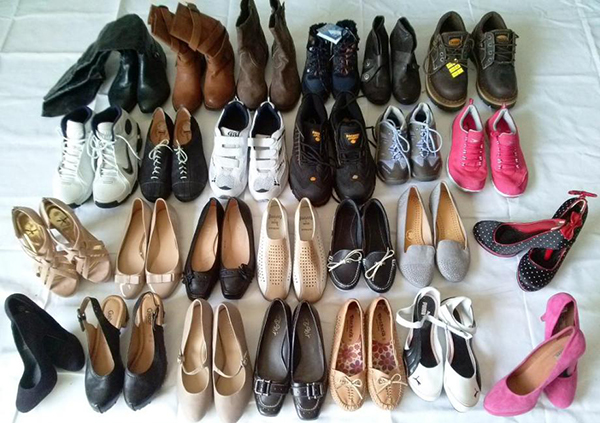 It is necessary to sort
It is necessary to sort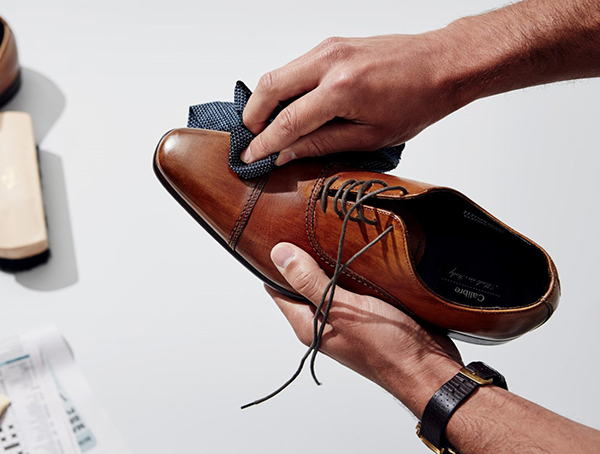 Clear dirt
Clear dirt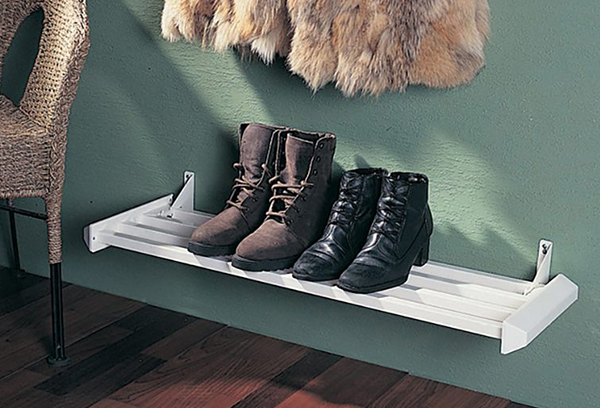 Dry naturally
Dry naturally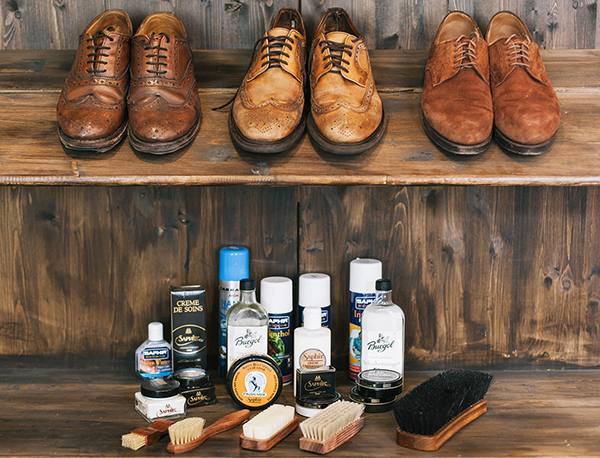 Treat with special means
Treat with special means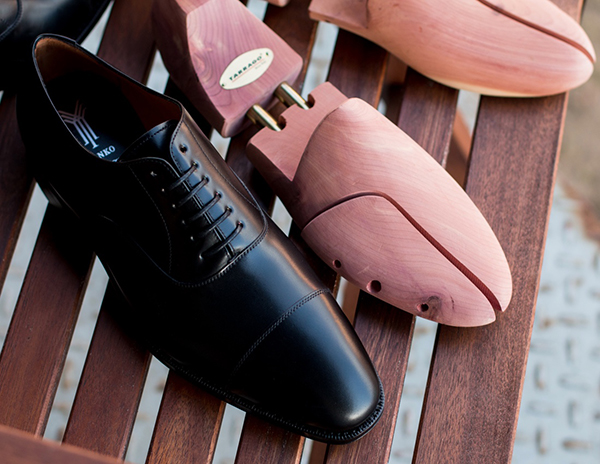 Use mold holders
Use mold holders
Preparing shoes
Before starting to lay out and hide the shoes in all possible places, so long as they do not interfere, you need to prepare them for long-term storage, even if it is seasonal, or just shoes that you use now, but also needing care and proper location.
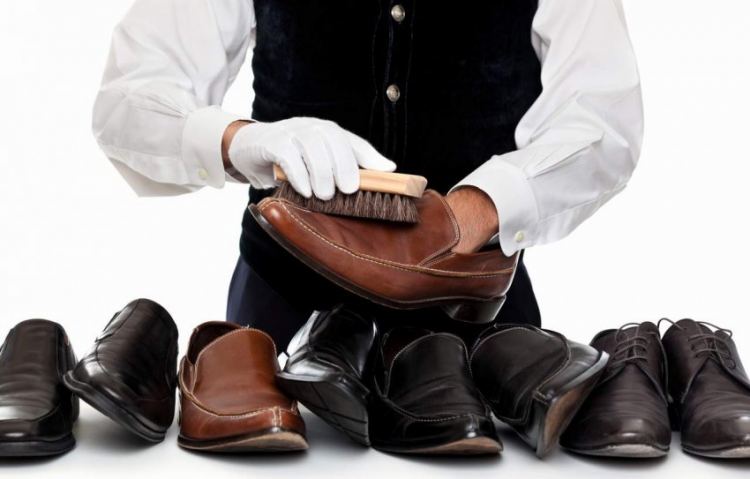
So, everything in order:
- Divide into seasonal: summer, winter, autumn-spring;
- Required for repair - to be repaired;
- Remove laces and insoles;
- Clean shoes: cloth - wash, leather - wipe with a damp cloth, suede - with a dry brush or squeezed sponge;
- Dry. All types of footwear should be dried only naturally; the sun's rays, heaters or batteries are not allowed;
- Treat the surface with special creams or sprays, allow time for impregnation;
- It is advisable to fill boots and boots with paper lumps or spacers to avoid deformation;
- Fold without bending the bootleg;
- Prepare storage space.
How to prepare shoes for long-term storage
The construction of a shoe rack is always preceded by the preparation of shoes, which consists of several stages:
- Sorting. Review all available pairs. If shoes, boots or sneakers have lost their presentation, part with them. The same should be done with shoes that cannot be repaired. Sorted pairs are easier to store. Therefore, put your boots, low shoes and ugg boots aside in one direction, and trainers, creepers shoes, sneakers in the other.
- The washing up. Remove dirt from the outsole and dust from the upper. Replace the insoles if necessary. If you don't want your shoes and boots to be colonized by the fungus, treat the inside with an antiseptic.
Properly prepared shoes can be stored in closed cabinets for years. At the same time, it does not acquire an unpleasant odor.
Interesting ideas
There are many ideas for storing shoes. Instead of traditional boxes, you can use any available means. For this, multi-colored baskets, linen nets, beautiful buckets and even drinking water bottles with a cut bottom are suitable.
An interesting life hack for creating a shoe museum in your own apartment. Some shoes are so beautiful that they deserve a place under glass. The walls of a hallway or a large corridor are quite suitable for this purpose. Organizing a home exhibition will turn seasonal cleaning into a real creative process. It is easy to make your own unusual fabric pockets that will not only protect your favorite shoes, but also decorate the hallway. You can create a composition of hooks on the wall, on which are placed cute children's shoes.
 In laundry buckets
In laundry buckets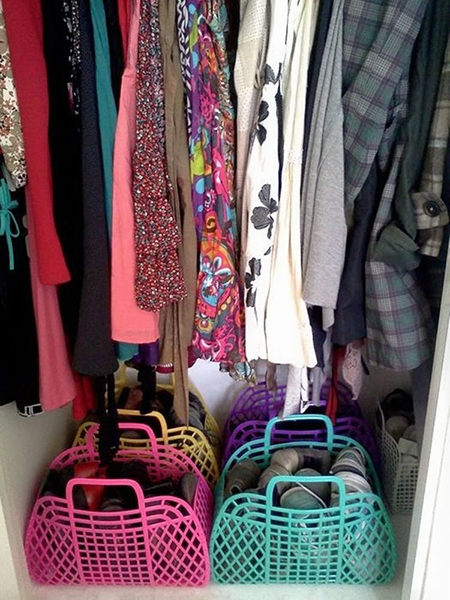 In multi-colored baskets
In multi-colored baskets In a cabinet with glass doors
In a cabinet with glass doors On hooks for clothes
On hooks for clothes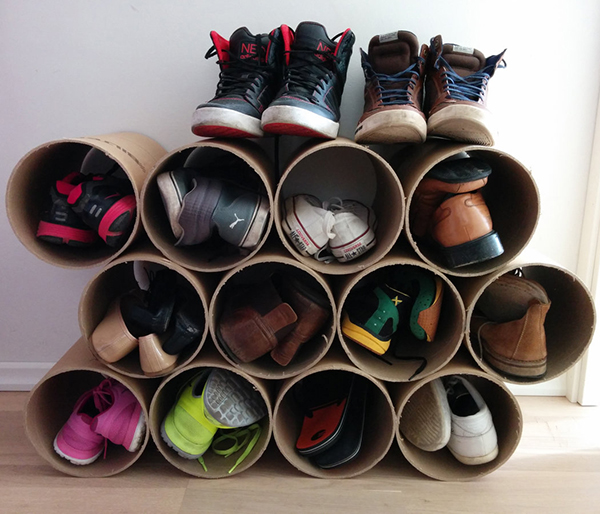 Shelves made of cardboard tubes
Shelves made of cardboard tubes
Preparing shoes for long-term storage
Before storing your shoes, they must be thoroughly cleaned. To do this, you need to use a soft rag, shoe polish. Also, before sending shoes to the mezzanine, it should be wiped with a rag soaked in castor oil.

White shoes must be wiped with a damp foam sponge and greased with colorless shoe polish. Winter boots and boots must be thoroughly washed from adhering dirt and dust, including the sole. Then treat with special compounds for leather or suede. For storage, you can use bags or cardboard boxes. Do not put your shoes on the shelves without packaging. So dust will appear on it, which significantly shortens the life of the shoe and can ruin its appearance.

Black leather shoes are treated with shoe polish or emulsion. To prevent the shoes from changing their shape, it is better to store them on special blocks. If there are none, you can put a paper ball inside the shoe, as is done in production. If your shoes have removable shoe insoles, take them out, rinse and dry them separately. It is not recommended to dry insoles and shoes near a radiator or other heat sources, as this can ruin their shape.

Solar ultraviolet light acts as an accelerator of the oxidation reaction of polymeric materials, for example, artificial rubber can harden much faster. The rubber elements can become cracked and the plastics can lose their hardness and strength. In a humid environment, synthetic rubber deteriorates. It loses its elasticity. The properties of natural leather also change. That is why it is necessary to store shoes in a dry and ventilated area, where there are no insects and rodents, which can also irreparably damage your favorite winter boots or shoes.

A closet, closed mezzanines, dry closets in a house or apartment are well suited for seasonal storage. By providing good storage conditions for shoes, you can significantly extend their useful life and maintain their original appearance. This is especially true for expensive and high-quality shoes, which may well last for several seasons, but improper storage can spoil them.
Storing shoes in the hallway
The first impression of the house begins with the entrance, and the pile of things creates an atmosphere of general chaos.
 If the humidity is high, you can use a tray with animal filler.
If the humidity is high, you can use a tray with animal filler.
Ideas for compact storage of shoes will harmoniously introduce elements that will become the highlight of the entire decor:
- Conventional plastic water pipes are cut into equal cylinders and connected together with glue. It will not be difficult to build a pyramid, a cube, or make a diamond-shaped organizer. The honeycomb is filled with shoes, sneakers and even boots.
- In case of high humidity and precipitation, you can put a shallow box with a grate and a double bottom, pour in the usual filler for animals. It perfectly absorbs water, keeping the flooring clean.
How to store winter shoes
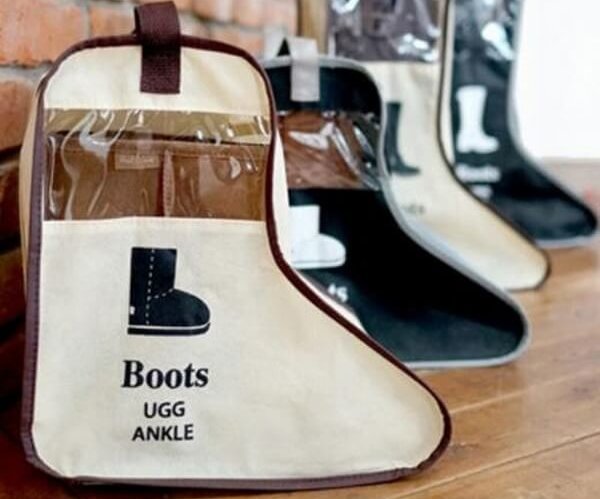 Shoes can be stored in hanging pouches that do not take up much wall space.
Shoes can be stored in hanging pouches that do not take up much wall space.
In the summer, you have to hide bulky ankle boots, boots and boots to make room for bright flip flops and high stiletto heels. Storing winter shoes does not require using the perimeter of the entire room; it is enough to apply the following tips:
take an ordinary clothesline, pull it in a closet or dressing room and fix a pair with a clothespin (up to 7 pairs can fit on 1 m);
knowing how to properly store winter shoes in a dressing room or closet, you can avoid damage and creases of the material, so it is important to keep its shape by placing a pair on a shelf or rack at an angle;
put each pair in a textile bag, before filling the boots with crumpled paper, hang in any room or fold on the mezzanine; just don't send your shoes to the balcony or garage (high humidity will easily ruin any material).
Storage methods
Storage options for seasonal shoes vary by location. On the mezzanine, under the bed or on open shelves, boxes, boxes with a lid, and plastic organizers are used. The contents of closed cabinets are less dusty; fabric bags are suitable as packaging.
Boxes
The traditional and convenient way is to store shoes in cardboard or transparent plastic boxes. Rigid construction protects boots from deformation, ventilation holes provide air exchange. The boxes are stacked on top of each other and placed in any suitable place.
If it is decided to purchase boxes of one sample, then they are selected to match the size of men's or women's shoes. Long boxes are provided for high boots. To make it easier to find the right pair, opaque packaging can be signed or provided with a photograph. Moreover, it is better to use the box all year round, in the summer for boots, and in the winter for sandals and shoes.
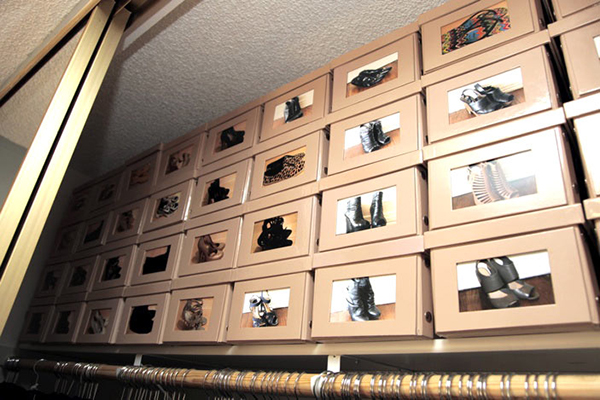
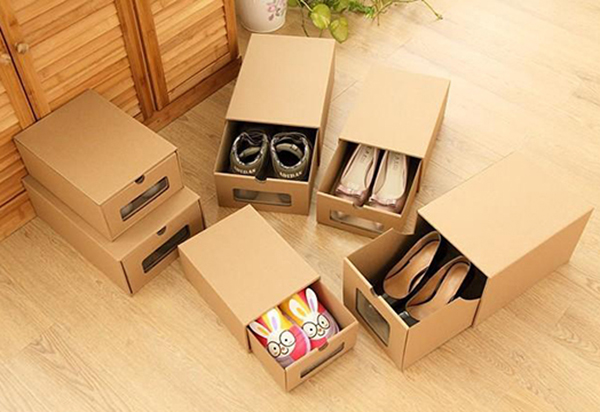
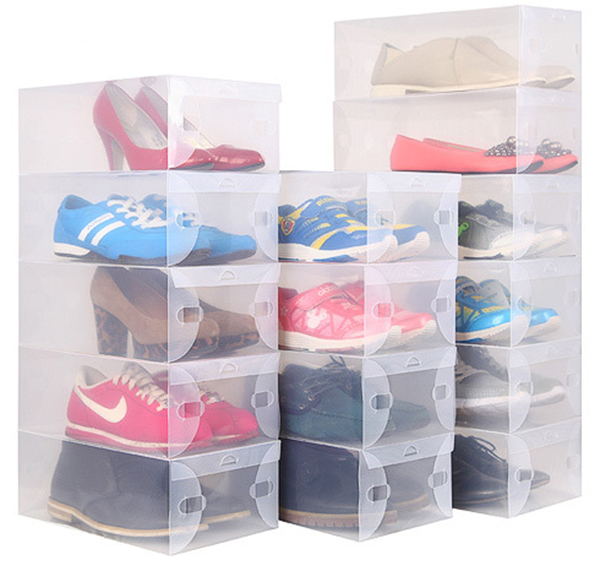
Shoe racks
For temporary storage of shoes in the hallway, racks with inclined shelves are used. Their main advantage is compactness (maximum depth 25 cm). The high rack can accommodate up to 30 pairs of summer shoes. This is a rational option for how best to store shoes if there is little space.
Usually the racks are made of metal or wood, less often of plastic. Niches are mesh or assembled from slats, which provides air circulation. Prefabricated racks, where the shelves can be installed at your discretion at different heights. The only downside is that there is no protection against house dust.


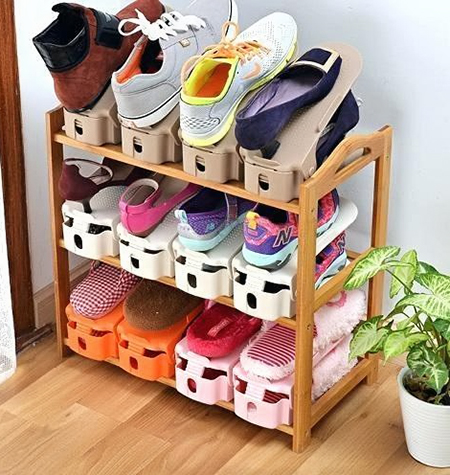
Shoe boxes
Storage boxes vary in capacity. They can be divided into standalone ones and those that are built into the design of the wardrobe. Drawers are part of the shoe storage system. Shoes, boots, short boots are placed in them. The content is clearly visible and easy to reach.
The multi-compartment standalone organizers are lightweight designs that look like a suitcase. The rigid frame is wrapped in durable fabric and has a carrying handle. In such a box there are from 3 to 12 compartments, the top cover is zipped. Small cases are convenient for storing shoes in the dressing room.They can be placed on a shelf or hung vertically by the handle.
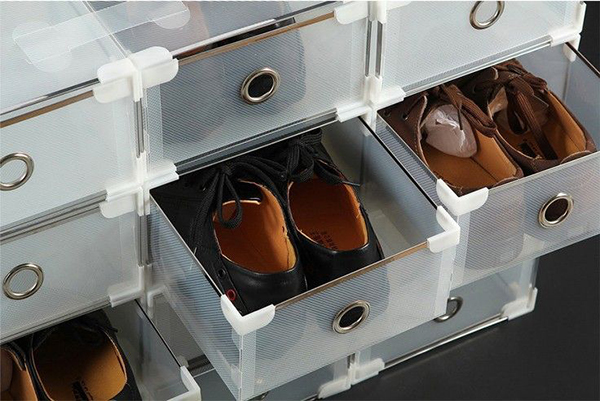

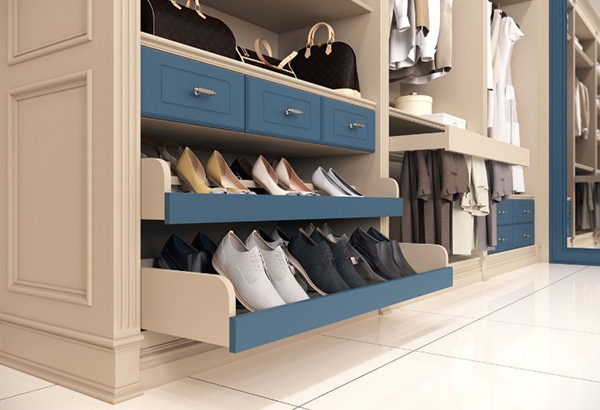
Cloth pockets
Textile pockets are used when there is a lack of space. In fact, this is a solution to the problem of how to store shoes and accessories without boxes. Modules with fabric compartments can be hung on the wall of any room: hallway, corridor, dressing room, nursery. They also use fabric pockets for storing shoes in a closet. The textile strip is attached to a door, side wall, or suspended from a bracket using a clothes hanger.
The method is suitable for storing slippers, sandals, soft shoes, with the exception of any molded shoes. Fabric pockets are convenient due to mobility, low cost, and easy to clean. If necessary, they can be easily removed; when rolled up, they take up very little space.
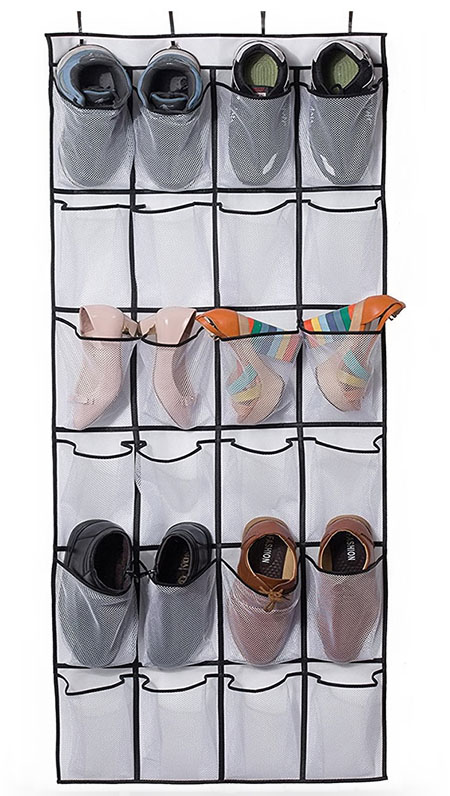
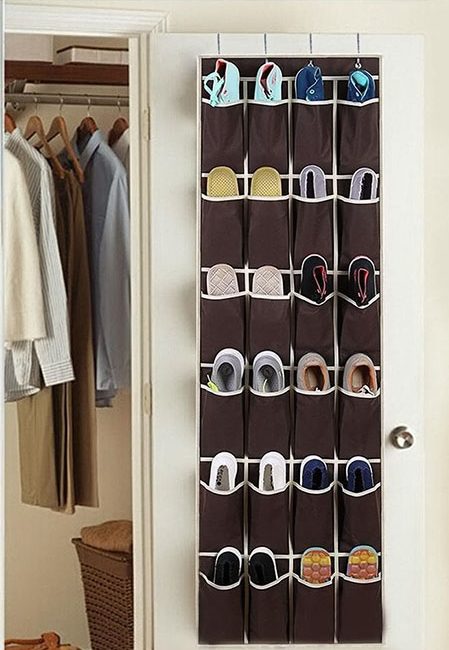

Shoe rack
Cabinets, the main purpose of which is the storage of shoes, are called shoe racks. Outwardly, they look like ordinary pedestals. There are open and closed shoe racks, as well as shoe storage systems that rotate around an axis. More complex designs are equipped with drawers and a soft seat.
The lineup is very wide. Small shoe racks are suitable for a small hallway, as they do not take up much space. Larger models, capable of accommodating almost all seasonal shoes, are intended for the dressing room.

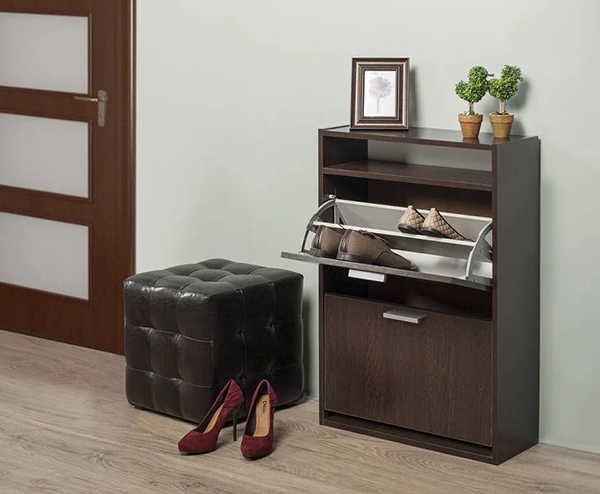
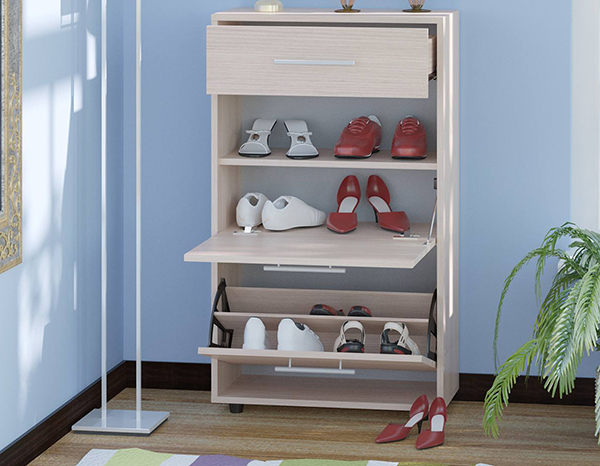
How to store shoes without boxes?
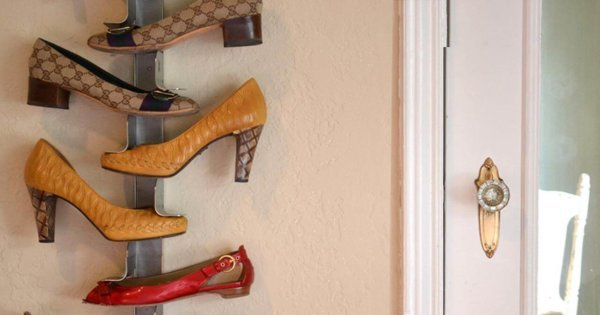
If there is not enough space for bulky boxes and containers, you should use these tips for organizing the space:
- Knowing how to store shoes correctly, you can put a hundred pairs in the smallest apartment: fasten a pair together with an elastic band, pack tightly in a hermetically sealed transparent organizer that fits easily on the loggia and under the bed.
- The stepladder is indispensable in the household. It will serve as an ideal practical solution - 1, 2, or even 3 pairs will fit on each step, depending on the width.
- A vintage sideboard is easy to place in any interior, and neatly folded pairs will be reliably protected from dust. It is worth taking note of the option for holiday shoes, which can be placed according to colors or seasons.
- How shoes are stored, if there is not enough space, design solutions will prompt: hollow furniture will hide shoes and sandals in its compartments, special pockets will allow each to occupy its own niche.
How to store shoes in a wardrobe

A sliding wardrobe is an irreplaceable piece of furniture for a large number of things. In such a closet, you can place both last year's and the new collection of the whole family:
- Textile organizers are attached to the outside and inside of the cabinet. Such options are more suitable for storing holiday, seasonal shoes, slippers, and for "today's" shoes it is better to leave space in the hallway.
- On the lower modules, you can place special shoe hangers for boots, and on ordinary hangers with the help of clothespins, attach sneakers, sandals, clogs.
- For winter shoes, it is better to use lower tube modules, securing boots and boots at an angle. This leaves enough space for outerwear.
Creative ideas for organizing space will help make an interesting design move. Practical devices will simplify everyday life, bring new notes to the interior.
Read more:
- How to store leather shoes
- How to quickly remove the smell of sweat from shoes at home
- How to remove black stripes from patent shoes
- Shoe care products
- How to whiten white sneakers at home
How to store shoes when space is tight

Small spaces hide a lot of possibilities. I would like every couple to find a place, and complete order reigned in the house. Even in a small room, you can add the required number of pairs:
- Open and closed chest shape. The former simplify the search - everything is immediately visible. For closed models, it is worth taking a small photo of the boots, attaching the photo on double-sided tape.
- You can use a clothes hanger to store shoes in the hallway.This is the right way to organize your everyday models and save space.
- For boots and ankle boots that are difficult to fit in a drawer or chest of drawers, there are separate gadgets. This can be a hanger on a long metal pipe, where each pair is attached to each other with a magnetic clothespin.
Storage space for shoes
For everyday storage of shoes, it is recommended to set aside a small wardrobe. The room should have good ventilation and shelves. If you do not have the opportunity to allocate space, resort to the help of sliding wardrobes, shoe boxes.
To keep your seasonal shoes safe, you can use cardboard boxes, organizers, or special containers. When choosing, be sure to look for ventilation holes, odorlessness and sufficient volume.
Organizer
Box
It is convenient and practical to store any shoes in boxes. The only drawback is that you will not see what product is there. However, you can sign. Modern models have a viewing window. You can buy it online.
Containers
The plastic container has a number of advantages over the classic cardboard box. Such a product has sufficient strength and transparency.
Take care of containers or boxes in advance for each pair of shoes. In this case, it is unacceptable to put sneakers, demi-season, exit shoes and work boots "in a heap". Otherwise, scratches and other damage will appear on the surface of the products.
Boxes
Seasonal shoes, most often, are stored in boxes on the lower section of the wardrobe, dressing rooms. Shop cartons remain after buying another pair of shoes or sneakers. It is better not to throw them away, but to put your favorite boots there before winter or shoes. The boxes are stacked in rows on spacious shelves under the cabinet wall. It is recommended that you sign the packaging to make it easier to find shoes. You can also cut out the same windows through which the content can be easily viewed. Another interesting option is photographs of the filling of the boxes, pasted on the ends of the packages.

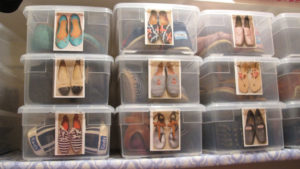
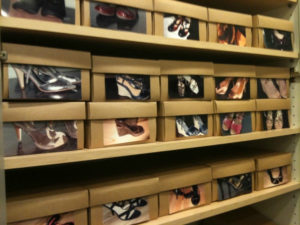 The images on the boxes correspond to the shoes inside; you can identify a pair of shoes by the photo on the box.
The images on the boxes correspond to the shoes inside; you can identify a pair of shoes by the photo on the box.
The box storage system is suitable if there is free space and large walk-in closets. If space is limited, clear plastic boxes are used. One container is enough for 8-10 pairs. With homemade cardboard dividers, you can organize your content so your boots or shoes don't hurt each other.
Unusual storage methods
Several ideas for organizing space for placing shoe stocks:
- An original way to store boots with a long shaft is with the use of hangers on the bar. The edge of the bootleg is attached with a clothespin to a special device or to a trouser hanger.
- The space under the stairs can be converted into pull-out shoe shelves. The result is a complete system for folding boxes, boxes, covers.
- For low boots, sneakers, flip flops, it is convenient to use a niche in the pouf. The space is divided into sections by cardboard or plastic partitions.
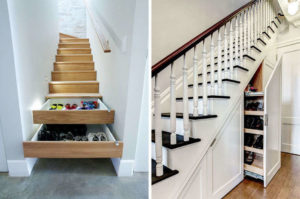
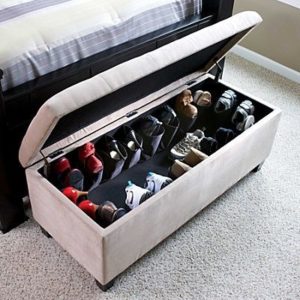
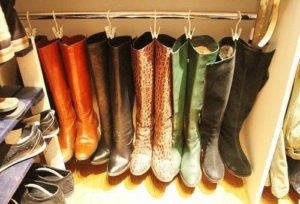
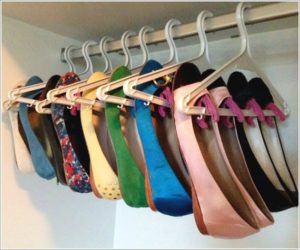
Organizing neat shoe sections in your closet is easy. The choice of storage system depends on the size and content of the cabinet. With a large number of shoes, you will need additional shoe racks, accessories to fill the space of shelves and drawers.
All kinds of organizers
Basically, organizers are comfortable fabric products that are fastened with a zipper. This functional unit has sealed cardboard walls to maintain its shape and a transparent top to allow visibility of the inner filling. Thanks to this, you do not have to waste time looking for the right shoes or boots.

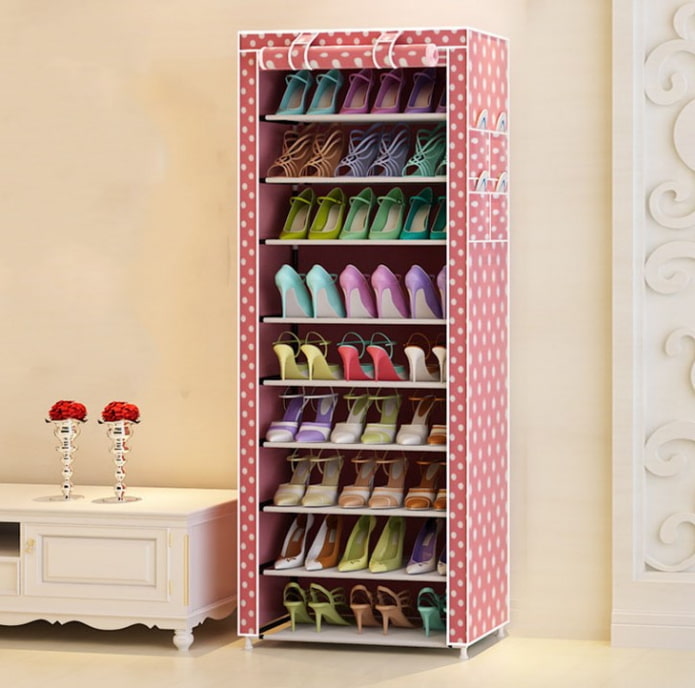
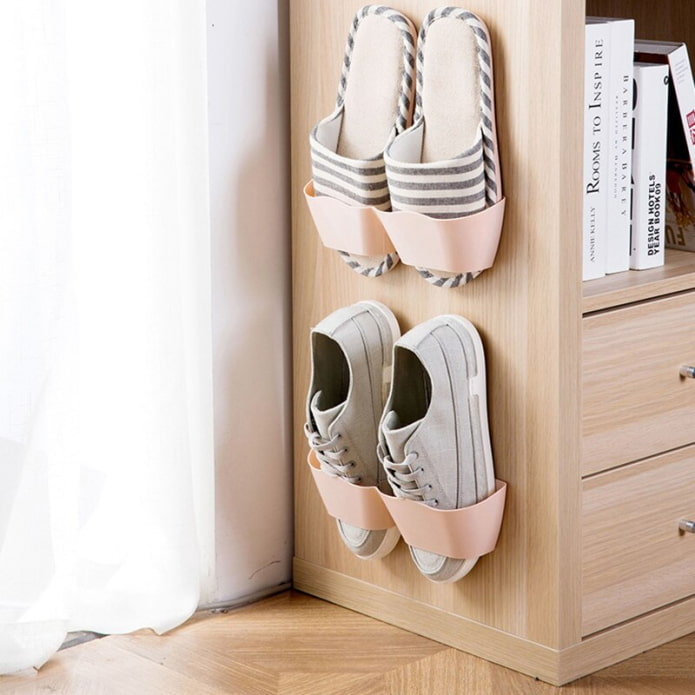
There are floor-standing and wall-mounted models. Hanging organizer on the door is perfect for a small room.Such a compact product with spacious pockets can be easily placed on the door leaf in the corridor or in the dressing room. However, it should be borne in mind that it will not be possible to put dirty shoes into organizers.

The photo shows a compact fabric organizer for storing shoes.
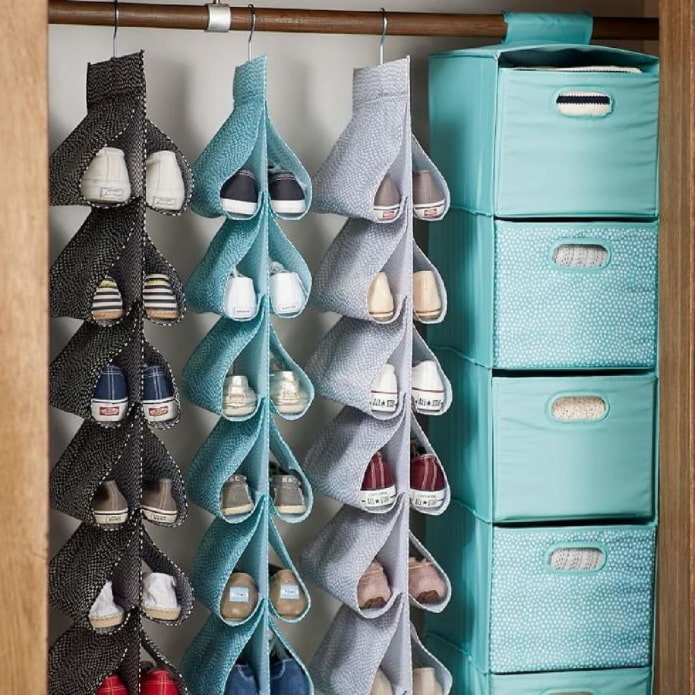
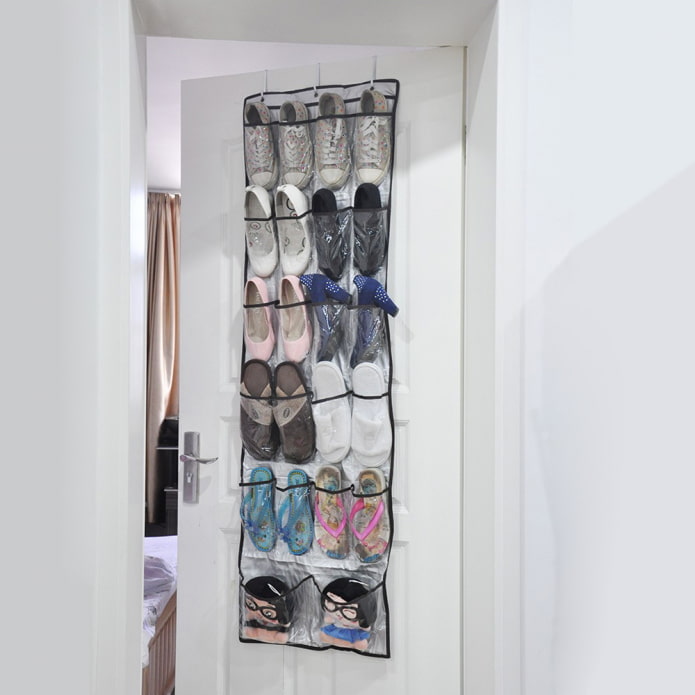
The nuances of storage, taking into account the material of manufacture
Already at the initial stage of sorting, attention is paid to the material from which the shoes, boots or boots are sewn. It is not customary to put shoes made of fabric in the same organizer with leather boots.
And suede does not tolerate neighborhood at all.
Elevated temperatures are undesirable for leather goods. Store your shoes in a well-ventilated closet or periodically ventilate.
Suede boots or shoes are characterized by the softness of the material. But this is not a reason to save space on them.
The boots should be fully straightened using the shoes, and the boot should be pulled over the spacers of a suitable size.
It is also important to know how to store fabric shoes. Most often these are sports shoes or moccasins that are worn on bare feet.
The material easily absorbs moisture, which means that at high humidity it can become a place for the rapid growth of bacteria.
Shoes are recommended to be stored by shifting with paper or cloth. You need to check shoe boxes for moths at least once every 1.5-2 months. For long-term storage, mold holders made of wood or foam materials are used to maintain the shape of the shoes or boots. At the same time, small folds, creases will be straightened, the shoes will be better ventilated.
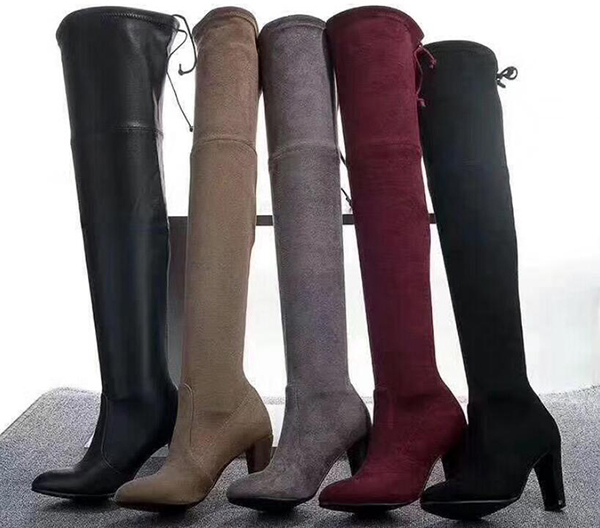 Store suede boots flat
Store suede boots flat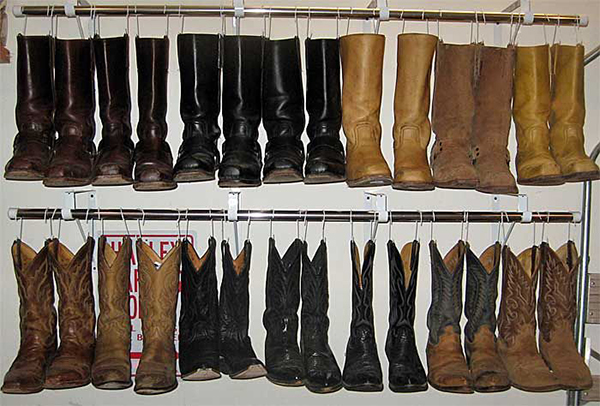 Store leather shoes in a well-ventilated closet
Store leather shoes in a well-ventilated closet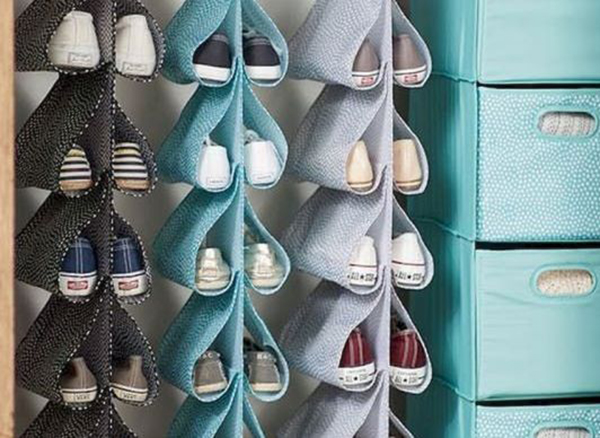 Store tissue in a dry place
Store tissue in a dry place Put paper in your shoes
Put paper in your shoes


